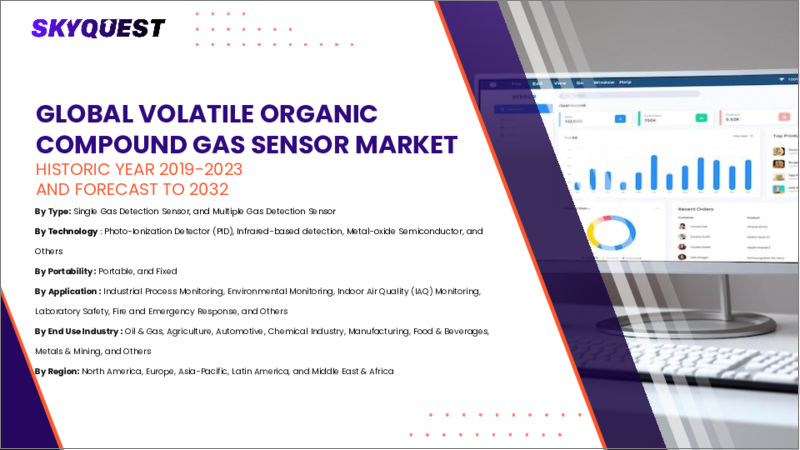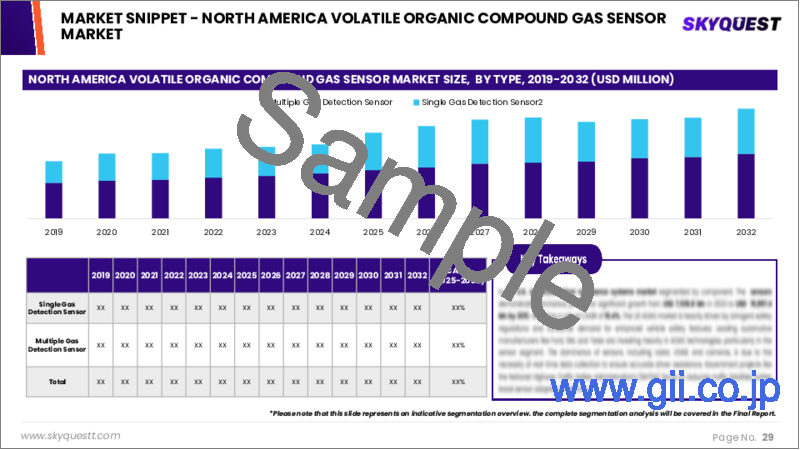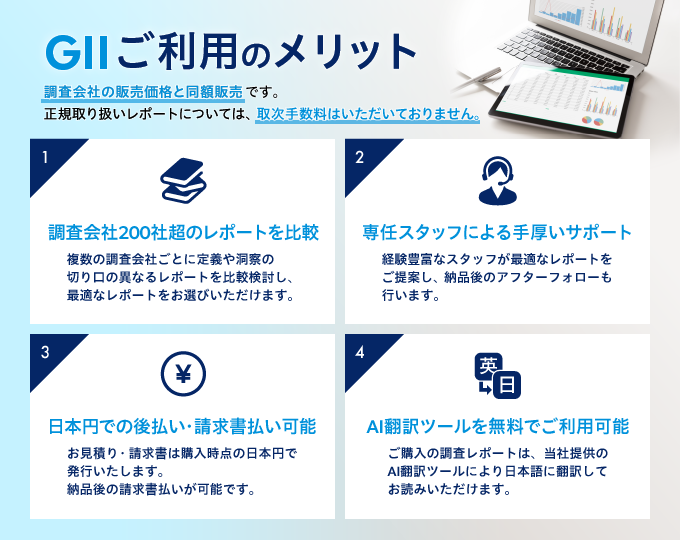|
|
市場調査レポート
商品コード
1603305
揮発性有機化合物ガスセンサーの市場規模、シェア、成長分析、タイプ別、技術別、用途別、地域別 - 産業予測、2024年~2031年Volatile Organic Compound Gas Sensor Market Size, Share, Growth Analysis, By Type, By Technology, By Application, By Region - Industry Forecast 2024-2031 |
||||||
|
|||||||
| 揮発性有機化合物ガスセンサーの市場規模、シェア、成長分析、タイプ別、技術別、用途別、地域別 - 産業予測、2024年~2031年 |
|
出版日: 2024年11月24日
発行: SkyQuest
ページ情報: 英文 181 Pages
納期: 3~5営業日
|
全表示
- 概要
- 目次
世界の揮発性有機化合物ガスセンサーの市場規模は、2022年に1億7,840万米ドルとなり、2023年の1億9,124万米ドルから、2031年までには3億3,353万米ドルに成長し、予測期間(2024年~2031年)のCAGRは7.2%で成長する見通しです。
揮発性有機化合物(VOC)ガスセンサー市場は、環境中の有害なVOCを検出・測定する需要の増加により、大きく成長する見通しです。VOCの排出源は、燃料の燃焼、輸送機関の排気ガス、家具や掃除用具などの室内材料など多数あります。VOCセンサーのモニタリング機器への統合が進むにつれ、特に正確な測定が可能で、小型で携帯性に優れていることから、市場の可能性が高まっています。様々なセクターでこれらのセンサーの採用が拡大しているのは、VOC排出に関して環境保護庁(EPA)が設定した基準とともに、鉱山安全衛生管理局(MSHA)や米国エネルギー省などの当局が施行する厳しい規制によってさらに後押しされています。さらに、特定の消費者製品にVOC表示を義務付けるカナダの最近の規制措置は、コンプライアンスの必要性と、その結果としてのVOCガスセンサー需要の急増を強調しています。このような規制状況は、業界がVOC排出に関連する環境問題に対処しながら安全基準を満たそうとしているため、高度な検出技術の採用を後押ししています。全体として、規制圧力と技術進歩の合流により、VOCガスセンサー市場は多様な最終用途で力強い成長を遂げます。
目次
イントロダクション
- 調査の目的
- 調査範囲
- 定義
調査手法
- 情報調達
- 二次データと一次データの方法
- 市場規模予測
- 市場の前提条件と制限
エグゼクティブサマリー
- 世界市場の見通し
- 供給と需要の動向分析
- セグメント別機会分析
市場力学と見通し
- 市場概要
- 市場規模
- 市場力学
- 促進要因と機会
- 抑制要因と課題
- ポーター分析と影響
- 競争企業間の敵対関係
- 代替品の脅威
- 買い手の交渉力
- 新規参入業者の脅威
- 供給企業の交渉力
主要な市場の考察
- 主要な成功要因
- 競合の程度
- 主要な投資機会
- 市場エコシステム
- 技術の進歩
- 規制情勢
- バリューチェーン分析
- ケーススタディ分析
- 顧客と購買基準の分析
- PESTEL分析
- マクロ経済指標
- 市場の魅力指数
- 価格分析
世界の揮発性有機化合物ガスセンサー市場規模:タイプ別・CAGR(2024年~2031年)
- 市場概要
- 単一ガス検知センサー
- マルチガス検知センサー
世界の揮発性有機化合物ガスセンサー市場規模:技術別・CAGR(2024年~2031年)
- 市場概要
- 光イオン化検出器(PID)
- 赤外線による検出
- 金属酸化物半導体
- その他
世界の揮発性有機化合物ガスセンサー市場規模:用途別・CAGR(2024年~2031年)
- 市場概要
- 石油・ガス
- 農業
- 自動車
- 化学産業
- 製造業
- 食品・飲料
- 金属・鉱業
- その他
世界の揮発性有機化合物ガスセンサー市場規模・CAGR(2024年~2031年)
- 北米(タイプ、技術、用途)
- 米国
- カナダ
- 欧州(タイプ、技術、用途)
- 英国
- ドイツ
- スペイン
- フランス
- イタリア
- その他欧州地域
- アジア太平洋(タイプ、技術、用途)
- 中国
- インド
- 日本
- 韓国
- その他アジア太平洋
- ラテンアメリカ(タイプ、技術、用途)
- ブラジル
- その他ラテンアメリカ地域
- 中東・アフリカ(タイプ、技術、用途)
- GCC諸国
- 南アフリカ
- その他中東・アフリカ
競合情報
- 上位5社の比較
- 主要企業の市場ポジショニング(2023年)
- 主要な市場企業が採用した戦略
- 市場の最近の動向
- 企業の市場シェア分析(2023年)
- 主要企業の企業プロファイル
- 会社概要
- 製品ポートフォリオ分析
- 企業のセグメント別シェア分析
- 収益の前年比比較(2021年~2023年)
主要企業プロファイル
- EcoSensors
- SGX Sensortech Limited
- GfG Europe Ltd.
- MicroJet Technology Co., Ltd.
- Renesas Electronics Corporation
- Aeroqual Limited
- Alphasense
- ABB Ltd.
- Bosch Sensortec
- Siemens AG
- City Technology
- Integrated Device Technology
- Ion Science Ltd.
- Figaro Engineering Inc.
- Sensirion AG
- TGS(Taguchi Gas Sensors)
- MSA Safety Incorporated
- Honeywell International Inc.
- Amphenol Advanced Sensors
- Riken Keiki Co., Ltd.
結論と提言
Global Volatile Organic Compound Gas Sensor Market size was valued at USD 178.40 Million in 2022 and is poised to grow from USD 191.24 Million in 2023 to USD 333.53 Million by 2031, growing at a CAGR of 7.2% in the forecast period (2024-2031).
The market for volatile organic compound (VOC) gas sensors is poised for significant growth, driven by the increasing demand for the detection and measurement of harmful VOCs in the environment. VOC emissions originate from numerous sources, including fuel combustion, transportation exhaust, and indoor materials such as furniture and cleaning supplies. The rising integration of VOC sensors in monitoring devices enhances market potential, particularly due to their capabilities for delivering accurate measurements, compact size, and portability. The growing adoption of these sensors across various sectors is further propelled by stringent regulations enforced by authorities like the Mine Safety and Health Administration (MSHA) and the U.S. Department of Energy, alongside standards set by the Environmental Protection Agency (EPA) for VOC emissions. Additionally, recent regulatory measures in Canada mandating VOC labeling on certain consumer products underscore the necessity for compliance and the resultant upsurge in demand for VOC gas sensors. This regulatory landscape supports the adoption of advanced detection technologies, as industries seek to meet safety standards while also addressing environmental concerns related to VOC emissions. Overall, the confluence of regulatory pressure and technological advancement positions the VOC gas sensor market for robust growth across diverse end-use applications.
Top-down and bottom-up approaches were used to estimate and validate the size of the Global Volatile Organic Compound Gas Sensor market and to estimate the size of various other dependent submarkets. The research methodology used to estimate the market size includes the following details: The key players in the market were identified through secondary research, and their market shares in the respective regions were determined through primary and secondary research. This entire procedure includes the study of the annual and financial reports of the top market players and extensive interviews for key insights from industry leaders such as CEOs, VPs, directors, and marketing executives. All percentage shares split, and breakdowns were determined using secondary sources and verified through Primary sources. All possible parameters that affect the markets covered in this research study have been accounted for, viewed in extensive detail, verified through primary research, and analyzed to get the final quantitative and qualitative data.
Global Volatile Organic Compound Gas Sensor Market Segmental Analysis
Global Volatile Organic Compound Gas Sensor Market is segmented by Type, Technology, Application and region. Based on Type, the market is segmented into Single Gas Detection Sensor, Multiple Gas Detection Sensor. Based on Technology, the market is segmented into Photo-Ionization Detector (PID), Infrared-based detection, Metal-oxide Semiconductor, Others. Based on Application, the market is segmented into Oil & Gas, Agriculture, Automotive, Chemical Industry, Manufacturing, Food & Beverages, Metals & Mining, Others. Based on region, the market is segmented into North America, Europe, Asia Pacific, Latin America and Middle East & and Africa.
Driver of the Global Volatile Organic Compound Gas Sensor Market
The Global Volatile Organic Compound (VOC) Gas Sensor market is primarily driven by the growing adoption of the Internet of Things (IoT), advancements in sensing technologies, an increasing emphasis on energy efficiency, and the development of smart cities. IoT-enabled VOC sensors facilitate connectivity with the internet and various digital devices, allowing for real-time remote monitoring of air quality. Additionally, innovations in nanostructured sensing materials present effective solutions for detecting low concentrations of VOCs in complex gas mixtures. Collectively, these factors are significantly contributing to the expansion and evolution of the VOC gas sensor market on a global scale.
Restraints in the Global Volatile Organic Compound Gas Sensor Market
One of the significant constraints facing the global volatile organic compound (VOC) gas sensor market stems from health and environmental concerns. Prolonged exposure to VOCs can lead to various adverse health effects, including respiratory problems and an increased risk of cancer, thereby generating a heightened demand for VOC abatement solutions. Furthermore, VOCs play a substantial role in contributing to air pollution and smog, which adversely affect the quality of the environment in communities. These health risks and ecological impacts emphasize the necessity for effective monitoring and management of VOC emissions, ultimately influencing market dynamics and growth potential.
Market Trends of the Global Volatile Organic Compound Gas Sensor Market
The Global Volatile Organic Compound (VOC) Gas Sensor market is increasingly aligning with sustainable practices as businesses strive to minimize their ecological footprint. This trend is driven by a rising demand for environmentally friendly solutions, prompting companies to invest in innovative technologies that facilitate the detection and management of VOCs. Manufacturers are prioritizing the development of low-VOC and VOC-free products, alongside advanced sensors that can accurately monitor air quality. With ongoing research focusing on water-based coatings and alternative materials, the market is poised for significant growth, reflecting a collective commitment to sustainability and environmental stewardship in industrial and consumer applications.
Table of Contents
Introduction
- Objectives of the Study
- Scope of the Report
- Definitions
Research Methodology
- Information Procurement
- Secondary & Primary Data Methods
- Market Size Estimation
- Market Assumptions & Limitations
Executive Summary
- Global Market Outlook
- Supply & Demand Trend Analysis
- Segmental Opportunity Analysis
Market Dynamics & Outlook
- Market Overview
- Market Size
- Market Dynamics
- Driver & Opportunities
- Restraints & Challenges
- Porters Analysis & Impact
- Competitive rivalry
- Threat of substitute
- Bargaining power of buyers
- Threat of new entrants
- Bargaining power of suppliers
Key Market Insights
- Key Success Factors
- Degree of Competition
- Top Investment Pockets
- Market Ecosystem
- Technological Advancement
- Regulatory Landscape
- Value Chain Analysis
- Case Study Analysis
- Customer & Buying Criteria Analysis
- PESTEL Analysis
- Macro-Economic Indicators
- Market Attractiveness Index
- Pricing Analysis
Global Volatile Organic Compound Gas Sensor Market Size by Type & CAGR (2024-2031)
- Market Overview
- Single Gas Detection Sensor
- Multiple Gas Detection Sensor
Global Volatile Organic Compound Gas Sensor Market Size by Technology & CAGR (2024-2031)
- Market Overview
- Photo-Ionization Detector (PID)
- Infrared-based detection
- Metal-oxide Semiconductor
- Others
Global Volatile Organic Compound Gas Sensor Market Size by Application & CAGR (2024-2031)
- Market Overview
- Oil & Gas
- Agriculture
- Automotive
- Chemical Industry
- Manufacturing
- Food & Beverages
- Metals & Mining
- Others
Global Volatile Organic Compound Gas Sensor Market Size & CAGR (2024-2031)
- North America, (Type, Technology, Application)
- US
- Canada
- Europe, (Type, Technology, Application)
- UK
- Germany
- Spain
- France
- Italy
- Rest of Europe
- Asia-Pacific, (Type, Technology, Application)
- China
- India
- Japan
- South Korea
- Rest of Asia Pacific
- Latin America, (Type, Technology, Application)
- Brazil
- Rest of Latin America
- Middle East & Africa, (Type, Technology, Application)
- GCC Countries
- South Africa
- Rest of Middle East & Africa
Competitive Intelligence
- Top 5 Player Comparison
- Market Positioning of Key Players, 2023
- Strategies Adopted by Key Market Players
- Recent Developments in the Market
- Company Market Share Analysis, 2023
- Company Profiles of All Key Players
- Company Details
- Product Portfolio Analysis
- Company's Segmental Share Analysis
- Revenue Y-O-Y Comparison (2021-2023)
Key Company Profiles
- EcoSensors
- Company Overview
- Business Segment Overview
- Financial Updates
- Key Developments
- SGX Sensortech Limited
- Company Overview
- Business Segment Overview
- Financial Updates
- Key Developments
- GfG Europe Ltd.
- Company Overview
- Business Segment Overview
- Financial Updates
- Key Developments
- MicroJet Technology Co., Ltd.
- Company Overview
- Business Segment Overview
- Financial Updates
- Key Developments
- Renesas Electronics Corporation
- Company Overview
- Business Segment Overview
- Financial Updates
- Key Developments
- Aeroqual Limited
- Company Overview
- Business Segment Overview
- Financial Updates
- Key Developments
- Alphasense
- Company Overview
- Business Segment Overview
- Financial Updates
- Key Developments
- ABB Ltd.
- Company Overview
- Business Segment Overview
- Financial Updates
- Key Developments
- Bosch Sensortec
- Company Overview
- Business Segment Overview
- Financial Updates
- Key Developments
- Siemens AG
- Company Overview
- Business Segment Overview
- Financial Updates
- Key Developments
- City Technology
- Company Overview
- Business Segment Overview
- Financial Updates
- Key Developments
- Integrated Device Technology
- Company Overview
- Business Segment Overview
- Financial Updates
- Key Developments
- Ion Science Ltd.
- Company Overview
- Business Segment Overview
- Financial Updates
- Key Developments
- Figaro Engineering Inc.
- Company Overview
- Business Segment Overview
- Financial Updates
- Key Developments
- Sensirion AG
- Company Overview
- Business Segment Overview
- Financial Updates
- Key Developments
- TGS (Taguchi Gas Sensors)
- Company Overview
- Business Segment Overview
- Financial Updates
- Key Developments
- MSA Safety Incorporated
- Company Overview
- Business Segment Overview
- Financial Updates
- Key Developments
- Honeywell International Inc.
- Company Overview
- Business Segment Overview
- Financial Updates
- Key Developments
- Amphenol Advanced Sensors
- Company Overview
- Business Segment Overview
- Financial Updates
- Key Developments
- Riken Keiki Co., Ltd.
- Company Overview
- Business Segment Overview
- Financial Updates
- Key Developments






